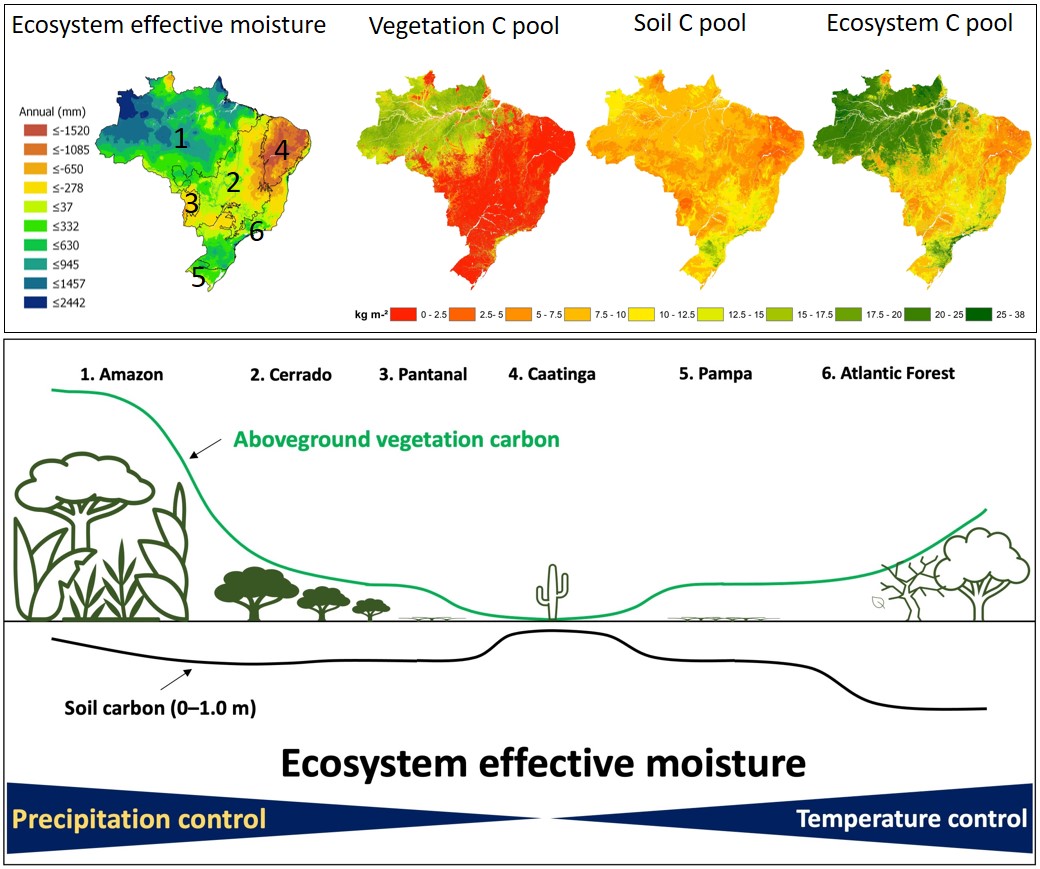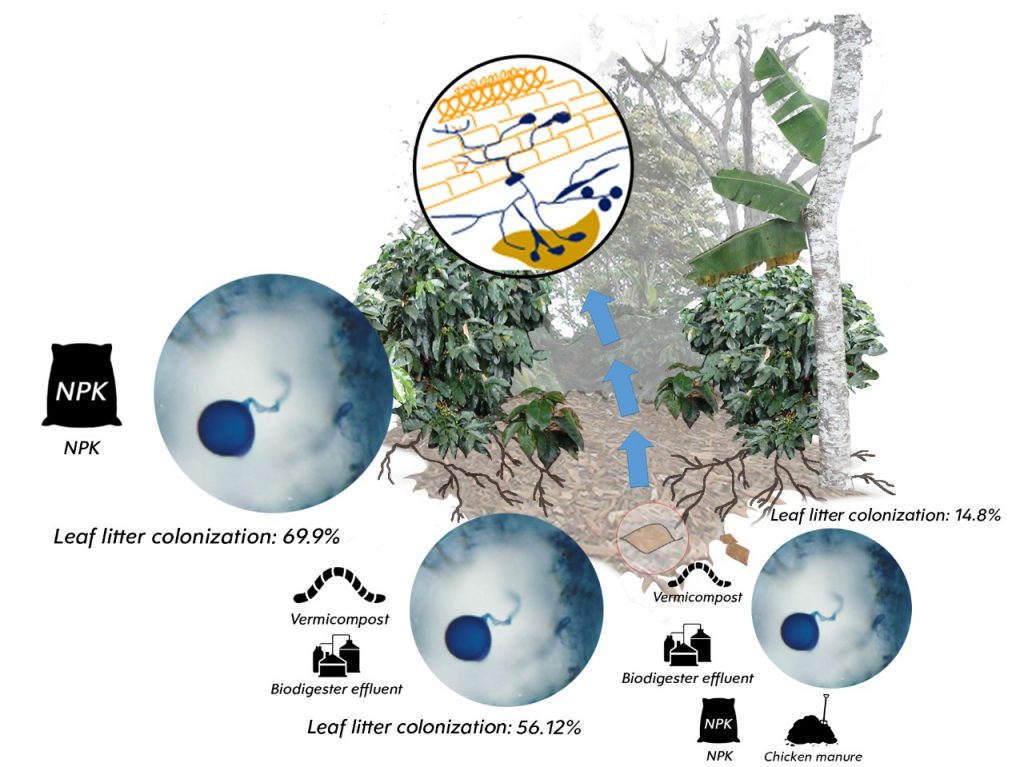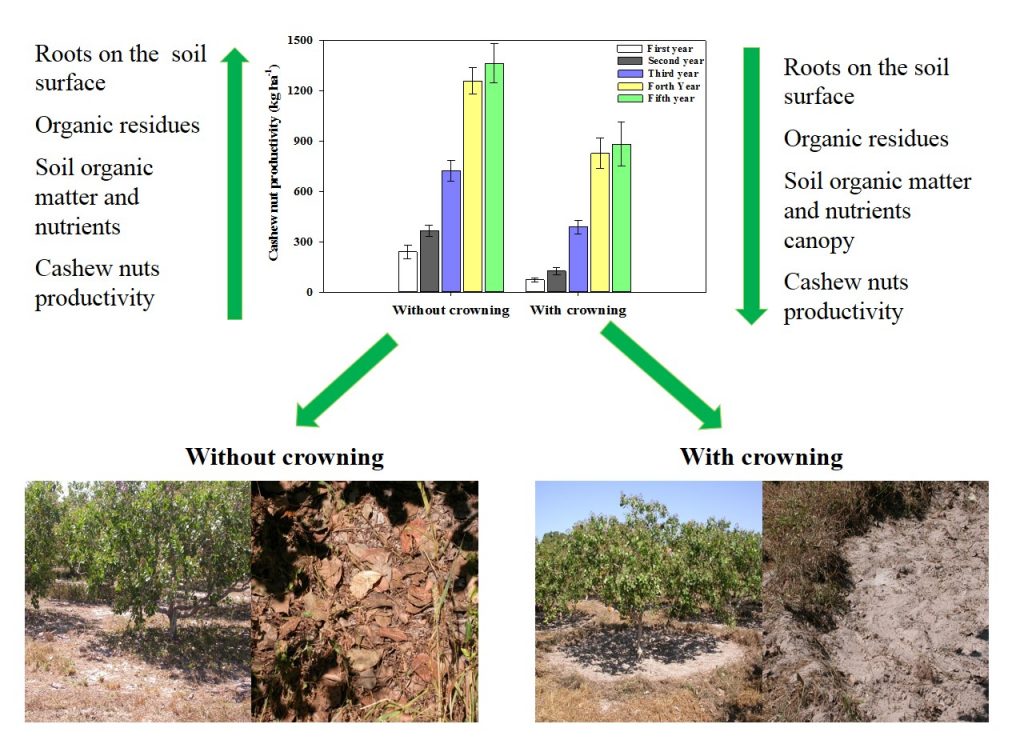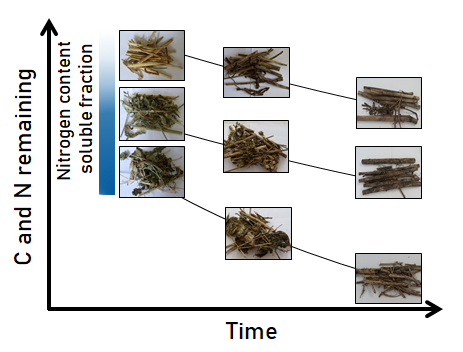Hierarchical feedbacks of vegetation and soil carbon pools to climate constraints in Brazilian ecosystems
24/nov/2021
ABSTRACT: It remains unclear whether temperature and precipitation exert independent control on tropical vegetation and soil C pools. Likewise, it is unknown whether the feedbacks of tropical C pools to climate constraints vary with nutrient availability. These aspects are critical to improving our ability to predict the response of tropical C pools to climate dynamics. This review aimed to assess climate data and the spatial distribution of vegetation and soil C pools across the Brazilian territory to investigate i) whether […]
Occurrence of arbuscular mycorrhizal fungi in leaf litter and roots of shaded coffee plantations under organic and conventional management
15/fev/2021
ABSTRACT Evidence of arbuscular mycorrhizal fungal colonization of mat litter in various ecosystems plus previous reports of external mycelium of those fungi and mycorrhizal roots in litter from coffee plants and shade trees on coffee plantations suggest that they have a relationship with closed direct nutrient cycling between organic matter and living roots. This relationship was first proposed more than 50 years ago. Mycorrhizal symbiosis in tropical crops is affected by agricultural management practices. This study aimed to assess the […]
Phytomass input and nutrient cycling under different management systems in dwarf cashew cultivation
27/nov/2020
ABSTRACT Rational management of spontaneous plants is an alternative for increasing productivity in tree crops. This study aimed to evaluate the impact of management systems between rows and under the canopy of early dwarf cashew trees on the soil chemical properties and light-fraction organic matter and cashew root systems; we also evaluated the nutrient inputs from the spontaneous plants phytomass and cashew leaves deposited on an Arenic Kandiustults. The management systems under study were disc harrowing (DH) and mechanical mowing […]
Summer Cover Crops Shoot Decomposition and Nitrogen Release in a No-Tilled Sandy Soil
01/nov/2019
ABSTRACT Cover crops have numerous benefits when used in a no-till system. Understanding the processes of decomposition and N release of summer cover crops (SCC) may help select species and management to be used in cropping systems. This study aimed to evaluate C and N loss of SCC shoots. Six SCCs were evaluated: velvet bean (Mucuna aterrima), pearl millet (Pennisetum americanum), dwarf pigeon pea (Cajanus cajan), sunn hemp (Crotalaria juncea), showy rattlebox (Crotalaria spectabilis), and jack bean (Canavalia ensiformis). The […]
Calcium and Magnesium Released from Residues in an Integrated Crop-Livestock System under Different Grazing Intensities
01/abr/2017
ABSTRACT Under integrated crop-livestock production systems (ICLS), plant and animal residues are important nutrient stocks for plant growth. Grazing management, by affecting the numbers of both plants and animals and the quality of residues, will influence nutrient release rates. The objective of this study was to evaluate the impact of grazing intensity on Ca and Mg release from pasture, dung, and soybean residues in a long-term no-till integrated soybean-cattle system. The experiment was established in May 2001 in a Latossolo […]
Soil Fertility and Electrical Conductivity Affected by Organic Waste Rates and Nutrient Inputs
01/ago/2016
ABSTRACT The composition of organic waste (OW) and its effect on soil processes may change soil fertility and electrical conductivity (EC). The side effects of waste use in crop fertilization are poorly understood for Brazilian soils. This study examined the effect of the addition of 15 different organic wastes to Oxisols and a Neosol on pH, base saturation, EC, cation exchange capacity (CEC at pH 7), and the availability of Al, macro (P, K, Ca2+, Mg2+ and S) and micronutrients […]
Cover Crops Effects on Soil Chemical Properties and Onion Yield
06/jun/2016
ABSTRACT Cover crops contribute to nutrient cycling and may improve soil chemical properties and, consequently, increase crop yield. The aim of this study was to evaluate cover crop residue decomposition and nutrient release, and the effects of these plants on soil chemical properties and on onion (Allium cepa L.) yield in a no-tillage system. The experiment was carried out in an Inceptisol in southern Brazil, where cover crops were sown in April 2012 and 2013. In July 2013, shoots of […]
DECOMPOSIÇÃO DE RESÍDUOS DE CULTURAS E MINERALIZAÇÃO DE NUTRIENTES EM SOLO COM DIFERENTES TEXTURAS
01/dez/2015
RESUMO A sustentabilidade dos sistemas conservacionistas de produção agrícola está intimamente ligada ao retorno dos nutrientes ao solo, por meio da decomposição dos resíduos vegetais. O objetivo deste estudo foi avaliar a decomposição de resíduos culturais e a mineralização de nutrientes em solos com diferentes texturas ao longo de 175 dias de incubação. Os tratamentos consistiram em fatorial 6 x 4 x 5, inicialmente composto por seis tratamentos, sendo quatro resíduos culturais: milho, braquiária, feijão, estilosantes e dois controles, ambos […]
DISPONIBILIDADE E RECUPERAÇÃO DE NUTRIENTES DE RESÍDUOS CULTURAIS EM SOLO COM DIFERENTES TEXTURAS
01/dez/2015
RESUMO Os resíduos de culturas agrícolas aportados sobre a superfície do solo, além da proteção física, podem liberar quantidades significativas de nutrientes ao solo pela decomposição deles; porém, a disponibilidade desses nutrientes às plantas é um fator pouco estudado. Avaliaram-se os teores totais de C orgânico e N, o pH e a disponibilidade e taxa de recuperação dos macronutrientes provenientes da ciclagem biogeoquímica de diferentes resíduos culturais ao longo do tempo, em solos com texturas construídas. Os tratamentos consistiram em […]
Suprimento de Nitrogênio para Culturas de Verão pela Aplicação Antecipada em Azevém Pastejado por Ovinos
01/set/2015
RESUMO Busca-se nos Sistemas Integrados de Produção Agropecuária (SIPA) maior ciclagem do nitrogênio (N). Este trabalho objetivou avaliar a adubação antecipada em azevém pastejado por ovinos no índice de nutrição nitrogenada (INN) das culturas de verão em SIPA. O estudo foi realizado em um protocolo de longa duração manejado, no período de inverno, sob dois métodos de pastoreio, contínuo e rotativo, e duas intensidades de pastejo, moderada e baixa, com quatro repetições. No verão, a área foi subdividida em dois […]




